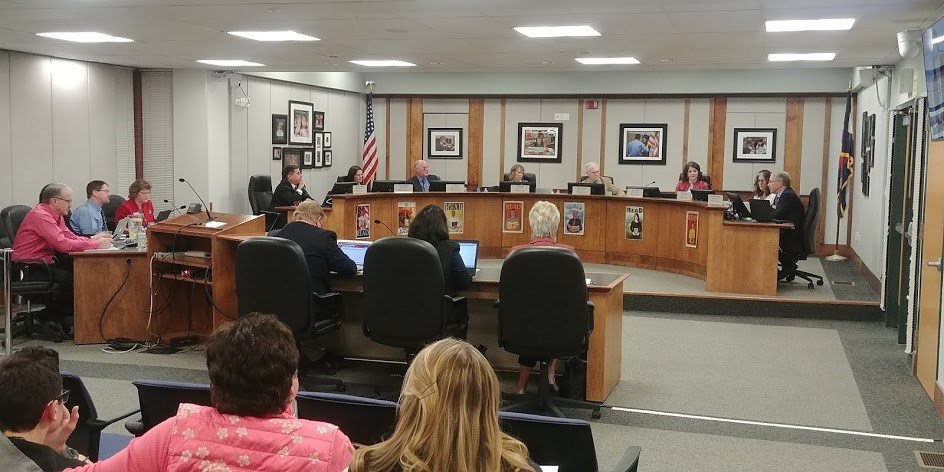This content was originally published by the Longmont Observer and is licensed under a Creative Commons license.
On Wednesday, March 14, the St. Vrain Valley school board approved enVisionmath2.0 as the new elementary math curriculum.
According to K-12 Mathematics Coordinator, Gregory George, "enVisionmath2.0 is what we call a balanced program. It emphasizes conceptual understanding, procedural fluency, and applications and problem solving with equal intensity. We believe this approach to math instruction provides a complete learning experience for students that honors understanding of concepts and the ability to solve math problems efficiently and accuracy. This program also offers the best of print and digital resources. All students will receive a 2-volume, full color student workbook each year, and the digital platform contains lesson videos that can be used to enhance classroom instruction and help students visualize mathematics concepts. In addition, there are digital assessment and practice options that give teachers and students immediate feedback. Of the four candidate programs we considered for adoption, enVisionmath2.0 was clearly the strongest in the two key area identified above."
In addition to approving the curriculum, the board also approved a contract with Pearson for the amount of "$1,660,000.00, for these textbooks and materials in FY18, based on the estimated student enrollment for 2018-2019," according to a memorandum presented to the school board.
The district also allowed a budget of $165,000.00 for staff training on the new curriculum.
The enVisionmath2.0 program uses visuals on the workbook pages as well as videos for in-class learning making the content more accessible to learners of all abilities. The program also uses manipulatives to allow students to play with concepts concretely.
George states, "There are many resources to support students performing below grade level and resources for students that are advanced. For second language learners, the focus on math vocabulary throughout the program and the use of pictures to accompany word problems provide supports that were deemed superior to any of the other candidate programs considered."
As stated, enVisionmath2.0 has a digital component that will allow parents and students to access the materials anywhere an internet connection is available.
"We will continuously support teachers in navigating the digital platform to find the resources they need for students. We will also need to communicate with parents how to access the digital materials if they wish to at home. This may include some introduction to enVisionmath2.0 and a demonstration of how to access at Back to School nights. We didn't emphasize the parent access at home during the pilot, as we wanted to see which technology-based components were deemed the most useful from the pilot teachers," remarks George.
Forty pilot teachers were selected to test the enVisionmath2.0 program in the 2017-2018 school year. All are in strong support of the program. (To find a list of the teachers, schools and grade levels who piloted the program, please refer to the pdf below.)
Fifth grade teacher, Kelly Addington of Longs Peak Middle School commented this about the new curriculum, "I like that with enVisionMath 2.0 mathematical concepts are explored in depth, allowing students to think about mathematics in a variety of ways. Students are able to gain a deeper understanding of the content and often find themselves creating algorithms that makes sense to them. This allows students to have ownership over the math ideas they are learning."
When asked how the new curriculum affected the i-Ready scores of the student in the pilot program, George commented, "Many of our pilot teachers self-reported their students outperformed their colleagues' classrooms that were not part of the pilot on the winter i-Ready assessment. The key is having materials fully aligned to the standards, as i-Ready and CMAS assessments are assessing those expectations."
"Built for the Common Core, i-Ready combines a valid and reliable growth measure and individualized instruction," according to the i-Ready website. The i-Ready assessments are given to elementary students throughout the school year to determine individual progress.
First grade and pilot teacher, Kylie Holmgren of Sanborn Elementary, told the school board, that her first-grade class displayed "the largest growth scores on i-Ready across the school."
According to the memorandum shared with the school board, "Parent surveys were made available to provide feedback. The parent feedback was very positive in support of the pilot materials, noting the rigor, the challenge it provides for students, and the amount and variety of problems included for students. Several comments represented positive changes in how their child’s mathematical thinking and problem solving capabilities had improved and how their child’s confidence in math and attitudes toward math had also positively increased. Numerous parents specifically commented on the quality of the mathematical explanations and example problems available (including the lesson videos), allowing them to help their students at home on assignments. Parent interaction and familiarity with the pilot materials and digital platforms was based on students showing their parents the program features, content, and navigation."
The weakness of the program that was identified by the district was stated to be that, "parents were unfamiliar with how to navigate the digital platform, and some parents were unaware that digital resources existed that could be used to support math at home," in the memo presented.
The district plans to accommodate this weakness and support parents by creating a document that explains how to access the digital materials from home as well as encouraging the schools to model the use of these materials at Back to School Nights.
According to George, "Overall, parents have been supportive of this program and have seen their students succeed in math this year."
To read the summary presented to the school board please refer to the pdf below. For further questions on the new curriculum please contact K-12 Mathematics Coordinator, Gregory George by sending an email to george_gregory



